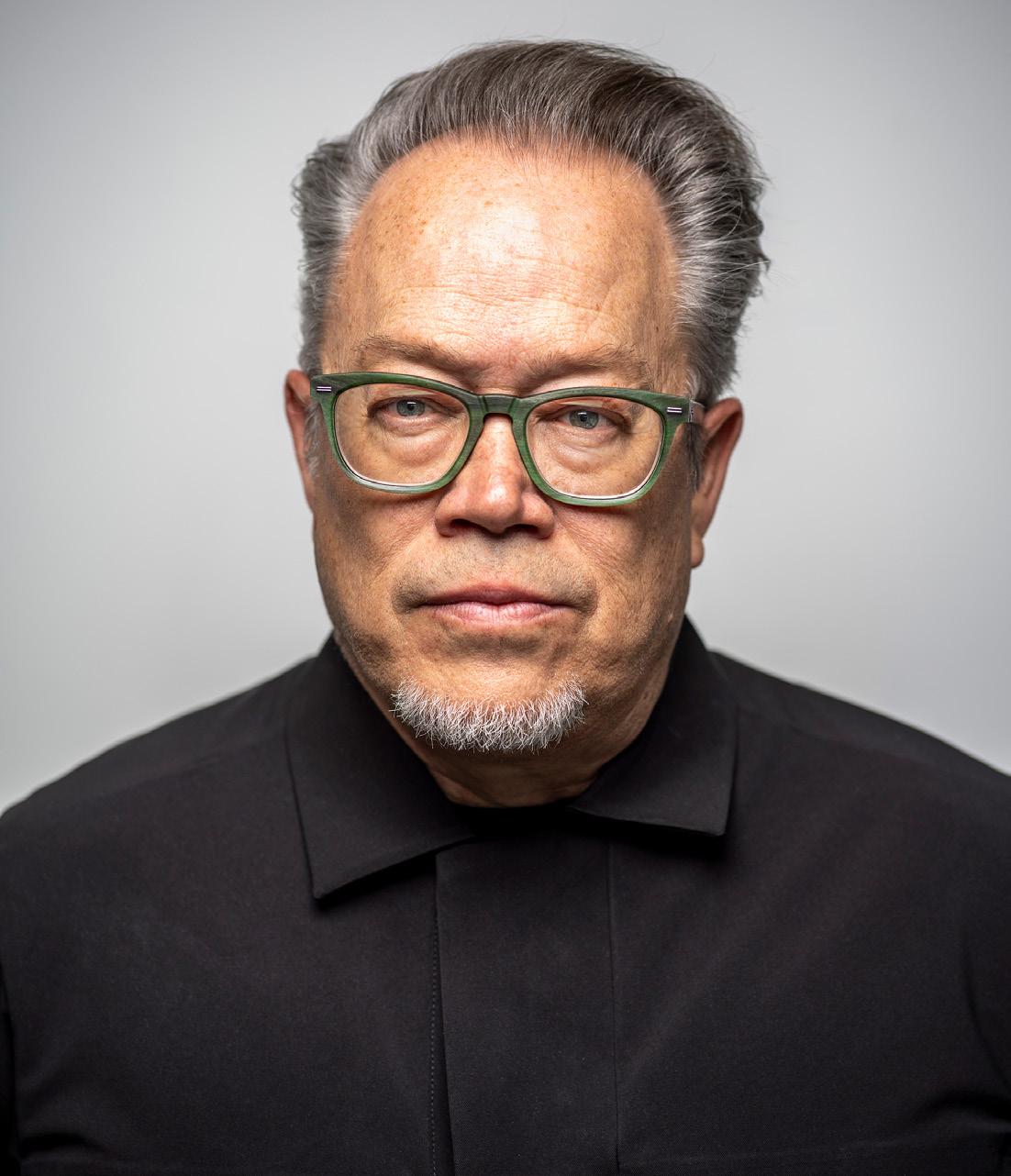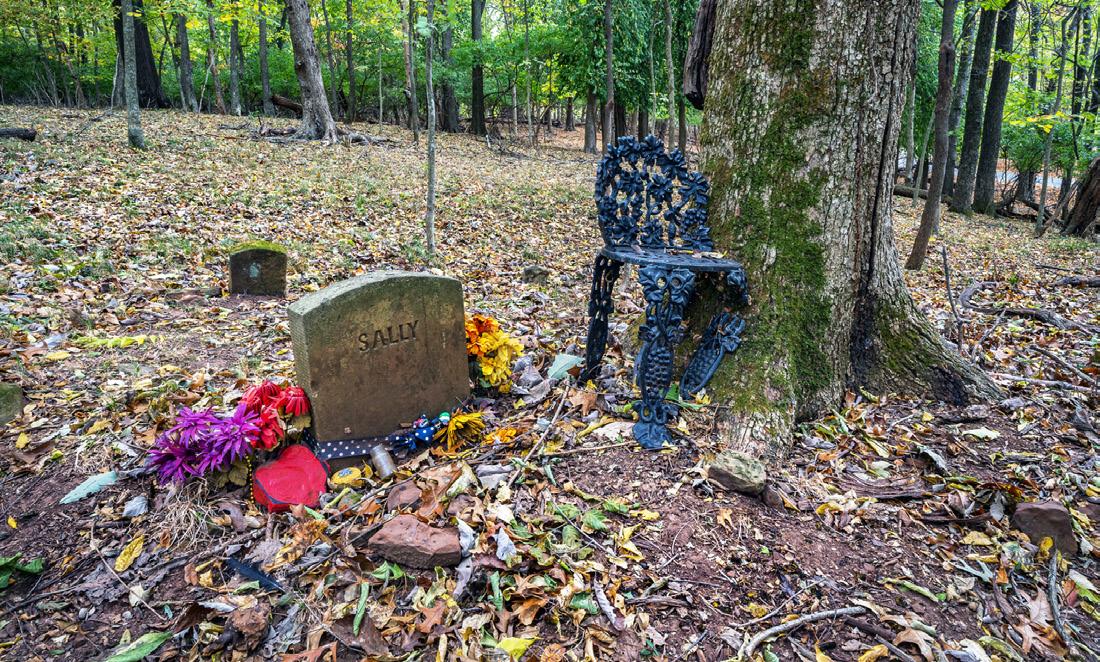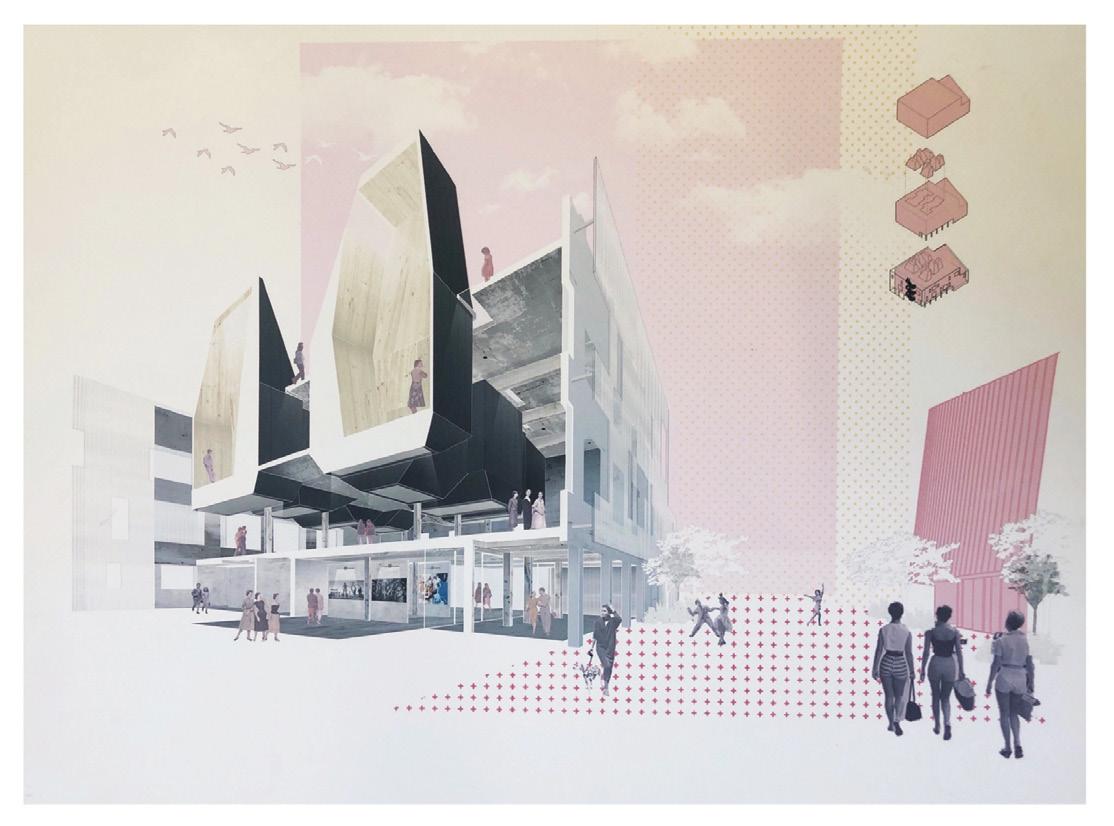
16 minute read
School News
Virtual Summer Design Camp
When the pandemic started in spring 2020, plans for that summer’s Fay Jones School Design Camp had to change because the typical in-person camps couldn’t happen. So Alison Turner, the school’s director of community education, secured a grant from the Alice L. Walton Foundation. The grant provided the means to create and produce 25 design education videos that virtually deliver the projects, discussions and tours that students would have experienced at an in-person camp. Additional support for the videos came from the U of A Student Success Center and the Dean’s Office of the Fay Jones School. The videos were released in summer 2020 on the school’s YouTube channel.
Advertisement
In these FAY Design Virtual Education videos, design workshop segments are supplemented with informational content and virtual tours. Viewers can learn about the school, meet some of the design students and get their perspective on being a design student, and also tour the U of A campus from the perspective of a design student. They can also virtually visit design firms and design professionals in Arkansas, learn about the life and work of architects Fay Jones, Edward Durell Stone and Marlon Blackwell, and visit several Arkansas cities to learn about the architecture and design in those places.
“We see that we now have the ability to bring design education to all students in Arkansas and beyond who may or may not have had the opportunity to attend one of our in-person Design Camps,” Turner said. “We also see this as a resource for K-12 teachers to bring design education into their classrooms.”
For summer 2021, the school will offer several Design Camp options — from all-virtual formats to one in-person session. In collaboration with PBS Learn, the online educational platform for Arkansas PBS, the school has developed six days of design camp education courses that students can pursue at their own pace and on their own schedule. These courses are recommended for students going into seventh through 12th grades.
Two weeklong, school-guided virtual camps will be held June 14-18 and June 21-25, also for students going into seventh through 12th grades. Students will use the PBS Learn courses and also meet daily via Zoom sessions with school design faculty and students for discussions, feedback and guidance. A two-week advanced virtual design camp will be held June 14-25, for students going into 11th and 12th grades. These students will also use a mix of the PBS Learn courses and daily Zoom sessions with school design faculty and students.
In addition, an in-person camp will be held June 14-18 at Vol Walker Hall on the University of Arkansas campus, for students going into ninth through 12th grades. This camp will operate under COVID-19 directives of the Arkansas Department of Health, the state of Arkansas and the University of Arkansas. Masks will be required.
The virtual Design Camp sessions are free and open to all students. The in-person Design Camp in Fayetteville costs $375, and need-based full and partial scholarships are available. Materials kits are available for virtual camps; materials kits will be provided to students in the in-person camp.
Registration for the school-guided virtual and inperson camps has closed. The deadline to register for the self-guided virtual camp courses is Aug. 1. More information can be found on the school’s website at: https://fayjones.uark.edu/news-and-events/designcamp.php/.
Luke Braswell (at right) films Beau Burris, then a fifth year Honors landscape architecture student, as he sketches on campus during the production of the design education videos in summer 2020.
Honors for Professor Marlon Blackwell
Marlon Blackwell has had a couple of big years. In 2020, he was awarded the Gold Medal by the American Institute of Architects and also was named the Southeastern Conference Professor of the Year. And this winter, he was elected to the membership of the American Academy of Arts and Letters — the highest form of recognition of artistic merit in the United States.
Joining the ranks of noted architects from around the world, Blackwell is the second architect practicing and teaching in Arkansas to be awarded the AIA Gold Medal since the program began in 1907.
Fay Jones, FAIA, was accorded the same honor in 1990. Jones, an Arkansas native, was a longtime professor and founding dean of the Fay Jones School as well as a member of the first class of architecture students. Blackwell, FAIA, is a Distinguished Professor and holds the E. Fay Jones Chair in Architecture in the Fay Jones School, where he has taught since 1992. He is founder and co-principal at Marlon Blackwell Architects, an architecture and design firm based in Fayetteville.
“Throughout his career, Marlon Blackwell has created inspiring architecture, transforming often limited resources into designs that celebrate each place and heighten all of our horizons,” said Robert Ivy, executive vice president and chief executive officer of the AIA, and the author of the AIA monograph Fay Jones. “Like former AIA Gold Medalist Fay Jones, Marlon Blackwell reminds us that powerful architecture can take place outside the traditional centers of media and fashion.”
Blackwell was the first University of Arkansas faculty member to receive the SEC Professor of the Year, the SEC’s highest honor for faculty, which annually recognizes a record of teaching and research and places the recipient among the elite in higher education. Winners are selected by the SEC Provosts from among the 14 SEC Faculty Achievement Award recipients. The SEC also provided Blackwell with a $20,000 honorarium.
“Across every area in which a faculty member can contribute to our mission — teaching, research, service — Marlon sets the standard and exceeds expectations,” said Chancellor Joe Steinmetz. “His contributions to the field of architecture, dedication to students and service to the campus and community are truly extraordinary. He has received the highest honor in his field as a professional architect while providing life-changing opportunities for students through architectural education.”
The American Academy of Arts and Letters was founded in 1898 as an honor society of the nation’s leading architects, artists, composers and writers. Membership is limited to 300 individuals who are elected for life and pay no dues. Including the newly elected members, Blackwell is one of only 21 architects and landscape architects in the Academy. He is the only member architect with a practice outside of the East and West Coasts; most are based in New York.
“You are welcomed into a fellowship of esteemed American artists who are making a real impact, and your work is acknowledged by these folks who are operating at the highest level of excellence in the discipline,” Blackwell said. “It’s amazing, and it’s amazing to be part of this accomplished group — I’m very humbled.”
Blackwell is also the only current living Arkansan to be elected to Academy membership. The architect and U of A alumnus Edward Durell Stone, who was born in Fayetteville and received multiple AIA design awards, was elected to the Academy in 1958. John Gould Fletcher, the poet and essayist, who was born in Little Rock and won the Pulitzer Prize for Poetry in 1939, was elected to the Academy in 1949, the same year he was a visiting professor at the U of A.

REVEALING REVEALING REVEALING
FAYETTEVILLE SYMPOSIUM
The virtual symposium “Revealing Fayetteville – A New Landscape” explored the history and landscape architecture practices of African American burial grounds and cemeteries before and after Emancipation. It was hosted in November 2020 by the Fay Jones School, in collaboration with the University of Arkansas Division of Diversity, Equity and Inclusion.
The symposium informed work being done in the fall 2020 semester “Engaging Site, Engaging Place” design studio that also incorporated advocacy and theory. Phillip Zawarus, the school’s 2020 Verna C. Garvan Distinguished Visiting Professor in Landscape Architecture, led the studio. Ken McCown, professor and department head of landscape architecture, and Jim Coffman, visiting assistant professor, co-taught the studio with Zawarus.
The final studio project focused on East Mountain Cemetery, a largely forgotten and ignored landscape a few blocks east of the downtown Fayetteville square. The cemetery dates back to 1838 and is the final resting place for white settlers, enslaved people and at least two known African Americans buried in the 1900s. The Northwest Arkansas African American Heritage Association holds the deed to the cemetery, which covers a little over an acre and contains many marked and unmarked graves.
This symposium intended to help design students and the broader community learn about the history of African American burial grounds and cemeteries established before and after Emancipation, explore case studies in university partnership on cemeteries, and understand the practice of landscape architecture in African American memorial landscapes.
Symposium panelists included Sharon Killian, a local artist who is president of both the Northwest Arkansas African American Heritage Association and Art Ventures NWA; Lynn Rainville, Ph.D., the inaugural Director of Institutional History at Washington and Lee University, in Lexington, Virginia; Katherine Ambroziak, associate professor and associate dean for academic affairs and research in the School of Architecture at The University of Tennessee, Knoxville; and Elizabeth Kennedy, founder and principal at EKLA PLLC in Brooklyn, New York.


In fall 2020, the Fay Jones School presented FAY TALKS, a new Facebook Live mini-lecture series exploring topics of interest to the field of architecture and design, featuring three faculty members in the Master of Design Studies graduate program. They highlighted topics of Resiliency Design, Retail Design and Integrated Wood Design, and each talk was followed by a brief Q&A session.
Jisun Lee, assistant professor in the Department of Interior Design, presented “Creating a Store That Tells You a Story.” Tahar Messadi, associate professor in the Department of Architecture and the 21st Century Chair of Sustainability, presented “21st Century — Turning Point for Mass Timber.” Steve Luoni, Distinguished Professor and director of the U of A Community Design Center, presented “The Future Resilient City.” All the videos can be found on the school’s Facebook page.
Integrated Design, Advanced Studio Student Awards

The Fay Jones School recognized the design work of several students during a September 2020 virtual awards presentation for the school’s Integrated Design Studio (IDS) Awards and the Advanced Studios Prize. A panel of internationally distinguished jury members discussed the work and publicly announced the students and projects being recognized.
“The exhibition of talent represented in all the students’ work is remarkable and to be commended — finalists and those who were awarded,” said John Folan, professor and head of the Department of Architecture. “It is invigorating to see the work and celebrate it within our own community, but to have such a diverse and esteemed group of internationally recognized jurors articulate admiration and respect for the students’ accomplishments makes it clear that it resonates globally.”
The focus of the fall 2019 semester Integrated Design Studio was “Trans-Logic Studio: Adaptive Reinventions, Wilson, Arkansas.” This studio was led by faculty members Marlon Blackwell (coordinator), FAIA, Distinguished Professor and E. Fay Jones Chair in Architecture; Emily Baker, associate professor in architecture; and Jonathan Boelkins, teaching assistant professor in architecture.
Students recognized with Integrated Design Studio Awards were Kennedy Van Trump, First Place; Ryan West, Second Place; Alexandria DeStefano, Third Place; and Sarah Little, Honorable Mention. For Van Trump’s first-place project, the jury noted several compelling attributes: “complex and interesting section; inventive; public access to the roof level; explores light and use with great sensitivity.” The jury said that West’s use of a public veranda in his second-place project “is a good intelligent move in this context” and that the images used were “simple and effective.” They applauded several aspects of DeStefano’s third-place project: “interesting site plan; use of gantry/crane idea intelligent; choice of materials good; studied structural strength of floor and found new use that is appropriate.” Little’s honorable mention was noted as a “spatially interesting proposition.”
For the Integrated Design Studio Awards, $2,000 went to the first-place winner, $1,500 to second place, $1,000 to third place, and $500 to honorable mention.
Three of the six finalist projects for the Advanced Studios Prize were awarded books as prizes. The First Place Award went to Joshua Levy for “In the Context of Emptiness, Detroit Wonderland Studio.” The Second Place Award went to Daniel Barker, Hunter Adkisson, Faith Cover, Amanda Davidson, Molly Dillard, Alexandria Hutchins, Sarah Schrom and Seth Soto for “Carb Complex: Big Picture.” The Third Place Award went to Miller Matlock for “North Fork Interdisciplinary Studio.”
The awards jury panelists for the Integrated Design Studio (IDS) Awards and the Advanced Studios Prize included: William Bates, FAIA, NOMA, LEED AP BD+C, national president, American Institute of Architects (AIA) 2018-2020; professor, Carnegie Mellon University; Kimberly Dowdell, AIA, NOMA, SEED, LEED AP BD+C, principal and director of business development, Hellmuth Obata and Kassabaum (HO+K) Chicago; president, National Organization of Minority Architects (NOMA) 20192020; Yvonne Farrell, FRIBA, co-founder and partner, Grafton Architects, Dublin, Ireland; 2020 Pritzker Architecture Prize recipient; 2020 Royal Institute of British Architects (RIBA) Gold Medal recipient; lead architects of the Anthony Timberlands Center for Design and Materials Innovation, Fay Jones School of Architecture and Design, University of Arkansas; and Billy Fleming, Wilks Family Director, Ian L. McHarg Center in the Weitzman School of Design at the University of Pennsylvania; author of “The 2100 Project: An Atlas for the Green New Deal” and “The Indivisible Guide;” Fay Jones School alumnus, B.L.A. 2011.
This design by Kennedy Van Trump was recognized with First Place in the Integrated Design Studio Awards.
MacKeith
Senior Fellow
The Design Futures Council (DFC), a built environment industry leadership consortium, named Dean Peter MacKeith as a 2020 Senior Fellow. The Senior Fellows program, which now includes some 200 distinguished leaders, honors its members’ significant contributions to the built environment industry disciplines, in architecture, landscape architecture, interior design, engineering and construction.
The council’s Senior Fellowship includes noted architects, designers and educators, as well as thought leaders from other disciplines and practices, among them architects David Adjaye, Neri Oxman, Steven Holl, Frank Gehry and Glenn Murcutt, designers Maya Lin, Bruce Mau, John Maeda, and Milton Glaser, urban designer Jan Gehl, and environmentalist and public servant Al Gore.
Senior Fellows of the DFC are recognized for significant contributions toward the understanding of changing trends, new research, or applied knowledge leading to innovative design models that improve the built environment and the human condition.
Dean MacKeith was joined in the 2020 cohort of inductees by, among others, Jim Anderson, principal and chair, Dialog Design; Fiske Crowell, principal architect, Sasaki; Don Davies, president, Magnusson Klemencic Associates; Peter Devereaux, chief executive officer, HED (Harley Ellis Devereaux); Ted Hyman, managing partner, ZGF Architects; Rob Miller, director, School of Architecture, University of Arizona; Adrian Parr, dean, College of Architecture, Planning, and Public Affairs, University of Texas, Arlington; Bradford Perkins, chief executive officer, Perkins Eastman; Scott Poole, dean, College of Architecture + Design, University of Tennessee, Knoxville; Ignacio Reyes, vice president and chief development officer, Leo A Daly; and Angela Watkins, principal, Shepley Bulfinch.
“I am so happy to see that Peter is being recognized for being one of the leading minds in his field by the Design Futures Council,” said Charles Robinson, provost and executive vice chancellor for academic and student affairs. “The University of Arkansas is truly fortunate to have him working daily as a scholar, teacher and administrator on our campus.”
MacKeith, a nationally recognized design educator and administrator, was appointed as the fifth dean of the Fay Jones School in 2014 and was reappointed in 2019. He has been recognized twice by Design Intelligence as a “design educator of the year” (in 2017 and 2019) and twice by the Association of Collegiate Schools of Architecture with national awards for “creative achievement in design education,” for his design studio teaching and curatorial work.
MacKeith serves as chair of the advisory committee for the Northwest Arkansas Design Excellence Program, a regional initiative of the Walton Family Foundation, and is a member of the editorial board of Places Journal for architecture, landscape architecture and urbanism. He also serves as Special Advisor to the Chancellor for Campus Architecture and Design at the U of A. He is currently overseeing the design and construction of the Anthony Timberlands Center for Design and Materials Innovation at the university, a regional center for research and development of new wood products and new approaches in sustainable construction materials.
The Design Futures Council — an independent and interdisciplinary network of design, product, construction and real estate leaders — was cofounded in 1994 by Dr. Jonas Salk and James P. Cramer.


A virtual panel discussion in November 2020 explored issues and experiences in the architecture and design professions related to diversity, equity and inclusion. The Fay Jones School presented “Designing While Black: A Conversation on Diversity, Equity, and Inclusion in the Design Professions,” which included Black alumni and faculty of the school — all practitioners and researchers — who shared their views and perspectives on DEI.
“The Fay Jones School community is committed to building a better world,” said Dean Peter MacKeith. “This commitment recognizes the essential, imperative work that needs to be done in design education and in the design professions to achieve full diversity, equity and inclusion. We need to change our culture: this transformation relies on changing the narratives of our design culture, on speaking out, listening attentively and engaging with each other in ways we have not done before.”
In this conversation, four panelists discussed the issues and opportunities with regard to diversity, equity and inclusion — as well as the lack of these — in the design professions.
“The year 2020, with the killings of George Floyd, Breonna Taylor and others, the massive protests happening during the summer, and the vulnerabilities of Blacks and other minority groups exposed by the COVID-19 pandemic, once again brought to the foreground the long-standing systemic racism and inequalities lingering in American society,” said Gabriel Díaz Montemayor, ASLA, an associate professor of landscape architecture and the school’s Diversity, Equity, and Inclusion (DEI) Coordinator. “Year 2020 is meant to be a transformative year, so we finally get serious and work towards erasing social, economic, and environmental injustices in the United States.”
The panelists were Ngozi Brown, AIA, ASID, NCARB, NCIDQ, M.Ed., LEED AP, EDAC, GPCP, principal of NOB A+D in Little Rock; Aeisha Smith, LEED AP; Reggie Wright, of RB Group Inc. and NOB A+D in Bentonville; and C.L. Bohannon, Ph.D., ASLA, associate professor of landscape architecture and director of the Community Engagement Lab at Virginia Tech.
Brown is currently a faculty member at the Fay Jones School and is a licensed architect and certified interior designer. She was the second African American woman to be licensed as an architect in the state of Arkansas. She shared her experience and perspective on the professional fields of architecture and interior design, as well as her teaching experiences.
Smith is an interior design alumna of the Fay Jones School and also holds a Master of Architecture from the Illinois Institute of Technology. She has professional experience working as an interior and architectural designer for large, award-winning firms in Chicago, including Epstein and HDR.
Wright is a practitioner of architecture and construction with more than 20 years of experience. He is also an architecture alumnus of the Fay Jones School. Wright has vast professional experience, with a particular focus on construction management in the state.
Bohannon is a landscape architecture alumnus of the Fay Jones School and an associate professor of landscape architecture at Virginia Tech, where he also directs the Community Engagement Lab. He shared his social and environmental justice perspective and experience.
Díaz Montemayor and Michelle Pribbernow, the school’s career specialist, served as event moderators, along with Jensen Johnson, an architecture alumna of the Fay Jones School and past president of the school’s National Organization of Minority Architecture Students chapter.










